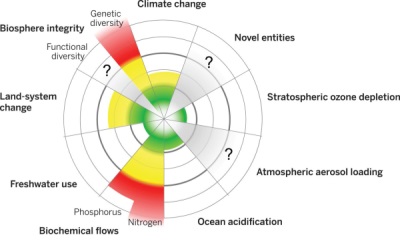Ecological sustainability
Ecological sustainability includes everything that is connected with the Earth's ecosystems. Amongst other things, this includes the stability of climate systems, the quality of air, land and water, land use and soil erosion, biodiversity (diversity of both species and habitats), and ecosystem services (e.g. pollination and photosynthesis). When it comes to the ecological systems, it is often possible to give quite a good definition of sustainability.
Production of goods and services must not compromise the carrying capacity of ecosystems, i.e. nature has to be able to regenerate utilised resources.
Amongst other things, ecological sustainability relates to the functioning of the Earth's biogeochemical system, which includes the following:
- Water (pollutants, groundwater levels, salinity, temperature, alien species)
- Air (pollutants, particles, ozone layer, climate system, noise)
- Land (pollutants, erosion, land use, alien species)
- Biodiversity (species and habitats (natural habitats), GMOs)
- Ecosystem services (e.g. pollination, photosynthesis, water purification, climate control)
Ecological sustainability sometimes also includes human health, to the extent that it is affected by the external environment in terms of pollutants, noise, etc.
The planetary boundaries

A major transdisciplinary research project led by the Stockholm Resilience Centre (stockholmresilience.org) has defined nine environmental problems, the so-called planetary boundaries (Steffen et al., 2015). If these are exceeded, it risks limiting the production capacity of the ecosystems. An attempt has therefore been made to quantify each area in order to be able to say something about how much impact is acceptable before threshold effects can be expected to be triggered.
The green zone indicates a "safe operation area", the yellow zone represents uncertainty (increased risk) and the red zone is the high risk zone. The planetary boundaries are represented by the circle at the intersection of the green and yellow zones. Three of the zones are not yet quantified and can therefore not be assessed (grey zones).
The Swedish environmental objectives system

The Swedish environmental objectives system consists of one generation objective, nineteen stage objectives and sixteen environmental quality objectives. Together, these can be used to gain an insight into what ecological sustainability includes in a Swedish context and what environmental work should lead to. The environmental quality objectives are followed up each year.
Learn more about the environmental objectives system (regeringen.se)
Learn more about the environmental quality objectives (in Swedish, miljomal.se)
